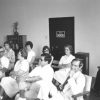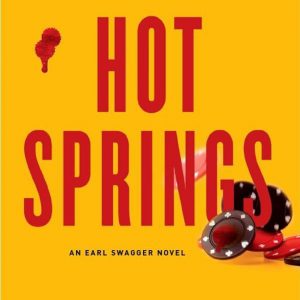calsfoundation@cals.org
Hot Springs [Novel]
Hot Springs is a novel written by Stephen Hunter and published by Simon & Schuster in 2000, with a paperback edition released the following year. The tough-guy thriller centers on the violent world of gangsters and gambling in postwar Hot Springs (Garland County). It is a fictionalization of what became known as the G.I. Revolt that was waged by returning World War II veterans who intended to root out corruption in their home state, particularly in Hot Springs. The book was Hunter’s first novel in his series featuring character Earl Swagger.
Stephen Hunter was born in 1946 and grew up in Illinois, where his father was a speech professor and his mother wrote children’s books. He was drafted into the U.S. Army, serving for two years with a unit that often performed ceremonial duties in Washington DC. Hunter served as film critic for the Washington Post, also authoring novels, including several in the Earl Swagger series after writing Hot Springs. Those include Pale Horse Coming (2001) and Havana (2003).
The hero of Hot Springs, ex–U.S. Marine sergeant Earl Swagger, who was awarded the Medal of Honor for his actions at Iwo Jima in World War II, returns to Arkansas in 1946. He was from Mount Ida (Montgomery County), which is not far from the “wide open” town of Hot Springs. In the novel, a special unit is set up by Garland County’s prosecuting attorney, consisting of a group of men who were “not tainted by the state’s corruption.” Their job was to raid casinos, houses of ill repute, and any place run by the mob.
The local godfather in the book is a mobster named Owney Maddox (a play on the real-life name of Owney Madden), who is said to run “a bit of New York in Arkansas” with help from visiting mobsters such as Charles “Lucky” Luciano. The book is full of local references, including the Arlington Hotel, Central Avenue, the African American district along Malvern Avenue, Happy Hollow, Hot Springs Creek (which a character calls “a sewer and a drain”), the Southern Club, and the Ohio Club. The names of the gleaming bathhouses along Central Avenue are all run together as “FordyceSuperiorHaleMauriceQuapawOzarkBuckstaffLamar.” There are also references to the rivalry heating up between Hot Springs and the mob-controlled gambling haven that is emerging in the desert at Las Vegas, Nevada.
In the acknowledgements section of the book, Stephen Hunter states that in 1946 there was indeed a veterans’ revolt in Hot Springs. Hunter says it was led by a heroic prosecuting attorney who ultimately vanquished the old-line mob and gambling interests that controlled “Arkansas’ most colorful town.” However, Hunter calls his profanity-laced book “grossly fictionalized.” He states that the real-life lawyer leading the G.I. Revolt was “in every way a better man” than his fictionalized version, and that the real-life gangland figure “was far and away a gentler, better fellow than my nasty Owney Maddox, and is still thought well of in Hot Springs.”
The cover of the hardcover edition displays a night-time photograph of Central Avenue and the Southern Club as they were in the 1940s courtesy of the Garland County Historical Society (GCHS). The author recognizes GCHS staff for being “unfailingly kind and helpful.” Hunter also cites a local resident for taking him on a tour of parts of Hot Springs with a darker history, pointing out the past location of casinos and brothels.
In its review, the Los Angeles Times stated that Hot Springs was a “thoroughly captivating novel,” adding that “Hunter is a consummate yarn-spinner whose eye for detail and ear for nuance…create their own riveting brand of reality.”
For additional information:
Hunter, Stephen. Hot Springs. New York: Simon & Schuster, 2000.
Lochte, Dick. “‘Hot Springs’ Targets Mob Violence.” Los Angeles Times, July 20, 2000. https://www.latimes.com/archives/la-xpm-2000-jul-02-cl-46934-story.html (accessed July 19, 2024).
Wendel, Tim. “Gunslinger Stephen Hunter.” Washingtonian, May 1, 2008. https://www.washingtonian.com/2008/05/01/gunslinger-stephen-hunter/ (accessed July 19, 2024).
Nancy Hendricks
Garland County Historical Society
 Divergent Prosperity and the Arc of Reform, 1968–2022
Divergent Prosperity and the Arc of Reform, 1968–2022 Literature and Authors
Literature and Authors Hot Springs
Hot Springs 



Comments
No comments on this entry yet.